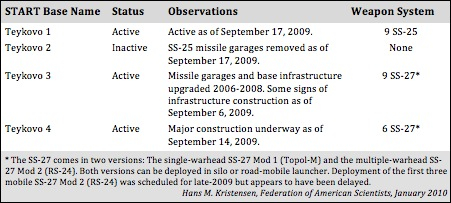 |
| Russia’s Teykovo 4 missile garrison northeast of Moscow is undergoing major upgrades for new SS-27 mobile nuclear missiles. Click image for large illustration of the changes. |
.
By Hans M. Kristensen
The latest overview of Russia’s nuclear forces produced by Robert Norris from NRDC and myself is now available on the website of the Bulletin of the Atomic Scientists.
We estimate that Russia currently (January 2010) deploys approximately 4,600 nuclear weapons, down from roughly 4,800 a year ago. The arsenal includes some 2,600 strategic warheads and about 2,000 warheads for nonstrategic forces. Another 7,300 weapons are thought to be in reserve or awaiting dismantlement for a total inventory of approximately 12,000 nuclear warheads. We estimate the weapons are stored at 48 permanent storage sites.
SS-27 Modernization at Teykovo
One of the interesting developments is Teykovo northeast of Moscow where four missile garrisons are in the process of upgrading from the SS-25 road-mobile intercontinental ballistic missile (ICBM) to the newer SS-27. One base still has SS-25s while the other three are in various stages of upgrading.
The SS-27 comes in two versions: single-warhead SS-27 Mod 1 (Topol-M) and the multiple-warhead SS-27 Mod 2 (RS-24). The two versions can be deployed in silos or on mobile launchers. All Teykovo missiles are mobile. Fifteen SS-27 Mod 1s have already been deployed, and the Russian military stated repeatedly in 2009 that the first SS-27 Mod 2 (RS-24) would become operational at Teykovo by the end of the year, which we wrote in our overview. That apparently did not happen after all and the system is now expected to become operational sometime in early-2010.
Commercial satellite images taken over the past five years clearly show major construction work at the garrisons. The newest images from late-2009 show that two garrisons appear to be active, one is undergoing major upgrades (see image above), and one was inactive as of September 2009.
| Teykovo ICBM Garrison Status 2009 |
 |
| Click table for larger version. |
.
Teykovo 1 (56°48’33.11″N, 40°10’15.89″E) appears to be active with the SS-25. Nine launchers (one regiment) are deployed. A satellite photo from September 17, 2009, shows no construction. The base might be converted to SS-27 in the future.
Teykovo 2 (56°55’0.42″N, 40°18’31.39″E) no longer has operational SS-25s with all missile garages missing in a satellite image from September 17, 2009. No construction has begun but the base might be converted to SS-27 in the future.
Teykovo 3 (56°55’56.98″N, 40°32’38.47″E) appears to have almost completed its upgrade. Major construction occurred in 2006-2008 and some remaining construction is visible in a satellite image from September 6, 2009. Nine SS-27s are operational.
Teykovo 4 (56°42’15.10″N, 40°26’25.29″E) appears to be in the process of upgrading to SS-27, with six of eventually nine launchers apparently operational. Deployment of the first three SS-27 Mod 2 (RS-24) was scheduled for late-2009 but appears to have been delayed to later this year.
Modernization and Fear Mongering
Russian nuclear modernization is a hot topic in Washington with some trying to block new nuclear arms reductions by claiming that the United States is falling behind. That is fortunately far from the truth (see here and here) and the upgrade at Teykovo has been long in the coming and slow.
Like the United States, Russia is reducing its nuclear weapons but also modernizing its remaining forces. How the Kremlin plans to reconcile this modernization with the pledge to pursue nuclear disarmament that president Dmitry Medvedev made with his U.S. counterpart in 2009 will be interesting to see in the years ahead.
This publication was made possible by a grant from Carnegie Corporation of New York and Ploughshares Fund. The statements made and views expressed are solely the responsibility of the author.
The FY2026 National Defense Authorization Act (NDAA) paints a picture of a Congress that is working to both protect and accelerate nuclear modernization programs while simultaneously lacking trust in the Pentagon and the Department of Energy to execute them.
While advanced Chinese language proficiency and cultural familiarity remain irreplaceable skills, they are neither necessary nor sufficient for successful open-source analysis on China’s nuclear forces.
Satellite imagery has long served as a tool for observing on-the-ground activity worldwide, and offers especially valuable insights into the operation, development, and physical features related to nuclear technology.
This report outlines a framework relying on “Cooperative Technical Means” for effective arms control verification based on remote sensing, avoiding on-site inspections but maintaining a level of transparency that allows for immediate detection of changes in nuclear posture or a significant build-up above agreed limits.